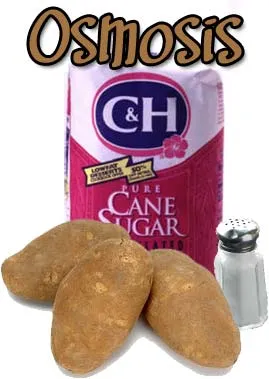 The Teacher's Corner
The Teacher's Corner
Osmosis Science Experiment
For this week's experiment, I am going to combine one aspect of the dino dig with the work that I have been doing on interactive exhibits on the science of water. To combine the two, we are going to look into the science of osmosis. Besides being a fun word to say, (and even more fun to say backwards), osmosis is a very interesting process.
 To find out how it works, you will need:
To find out how it works, you will need:
- 3 small bowls or cups
- water
- salt
- sugar
- a potato
- a knife
- paper
- pencil or pen
Fill each of the bowls about half full of water and place them on a table or flat surface where they can sit for several hours without being in the way. Use the paper and pen to make a label for each bowl. One label should say "Plain Water", one should say "Salt" and one should say "Sugar." Next you want to add salt to the water in the bowl labeled "Salt." Keep adding salt and stirring until no more will dissolve. Do the same with sugar in the other bowl.
CAREFULLY use the knife to cut three slices from the middle of the potato. Each slice should be about 1/4 to 1/2 of an inch thick. The thinner you make the slices, the faster you will see results. Place one slice in each bowl. Now come the hard part. Go do something else for 30 minutes. Fix yourself a snack, read a little and soon it will be time to check the experiment.
After 30 minutes, take the potato out of the bowl labeled "Salt" and examine it. What do you see? It seems to have wilted, getting very soft and flexible. Put it back and look at the slice in the sugar water. It is also flexible, but probably not as much so. Rinse your fingers to get rid of any salt or sugar and pick up the slice in the plain water. What do you notice about it? It is not wilted at all. In fact, it is even more rigid than it was when you put it in!
Why did that happen? It has to do with a process called osmosis. The potato is made up of tiny, living units called cells. Each cell is surrounded by a cell membrane which acts much as your skin does. It keeps the cells parts inside and keeps other things outside, protecting the cell. While this membrane stops most things, water can pass through it. The water tends to move towards higher concentrations of dissolved chemicals. That means that if the water outside the cell is saltier than the water inside, water will move from the inside of the cell to the outside. That is what happened to the slice of potato in the salt water. As the water left the cell it was much like letting the air out of a balloon. As more and more of the cells lost water, the slice of potato became soft and flexible. The same thing happened for the sugar, but since the cells in the potato contain more sugar than they do salt, the cells did not get as soft.
When you put the potato into the plain water, the reverse happened. Water moved from the outside, where there was no salt or sugar, into the cell where there was some. This caused the cells to swell up, becoming very stiff.
If the slices have not done enough, you can let them sit longer. I even tried rinsing the slices and switching them, so that the soft, salty slice went into the plain water and the stiff, plain water slice went into the salt water. What do you think happened? Try it and see.
OK, now we know about osmosis, and we did talk a lot about water, but what does that have to do with digging dinosaurs? One of the important things to keep in mind when you are working outside in the hot sun all day is to drink plenty of water. Osmosis works the same way for your cells as it does in the potato. If you sweat a lot, you are losing water. This can raise the concentrations of salts in your blood. Osmosis takes over and starts to pull water out of your cells, which is not a good thing. It is very important to drink LOTS of water if you are sweating a lot, and I know that we will be sweating a LOT while we are digging.
It is also important to eat salty things if you are sweating a lot. Sweating removes salt from your body as well, which can also mess up the balance of osmosis. When you eat the salt, your body will absorb enough to keep that balance and keep you going. Often people take salt tablets if they are sweating a lot, but I found this WONDERFUL, salty beef jerky that I think will keep me well balanced (physically at least) and it sure tastes good.
 Check out more Science Experiments
Check out more Science Experiments
All lessons are brought to you by The Teacher's Corner and Robert Krampf's Science Education Company.
Robert Krampf's Science Shows thehappyscientist.com